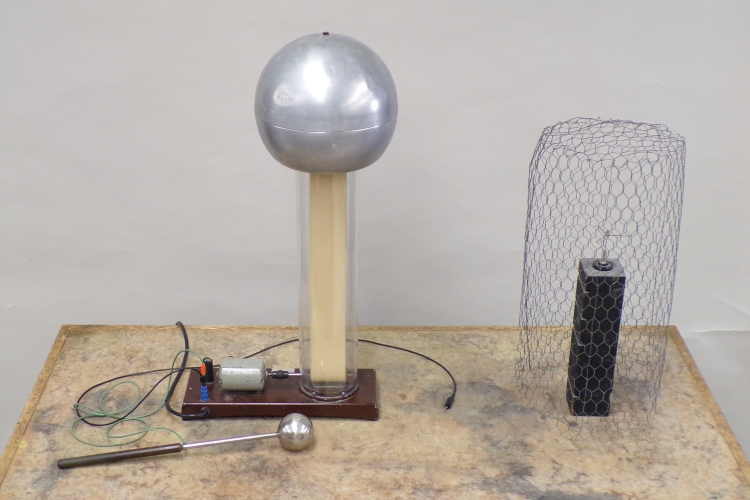
With the electrostatic pinwheel sitting on the black wood block in the open, when you turn on the Van de Graaff generator, the pinwheel begins to spin. When you place the chicken wire over the pinwheel and block as shown above (with the generator turned off and the dome discharged), and then turn the generator on, the pinwheel sits still. If you wish, you can ground the cage and place it over the pinwheel while the pinwheel is spinning. If you do this, the spinning pinwheel, slowed by drag and friction in the pivot, will eventually come to a stop. Important! Always use the grounded wand to turn the generator on and off.
Shown enclosed in the chicken wire cage is an electrostatic pinwheel (sometimes called an electric whirl). As described on the page for demonstration 56.30 -- Electrostatic pinwheel, when placed in the electric field of the van de Graaff generator, the pinwheel acquires charge, the distribution of which on the surface of the pinwheel produces an electric field around it. The magnitude of the electric field near any part of the pinwheel depends on the surface charge density there. The pinwheel has three arms, each of which has at the end a short section bent at right angles to it, which has a point at its end. At these points, the electric field is great enough to cause corona discharge, which ionizes the air surrounding the points. Repulsion between the resulting ions and the charged points produces a torque on the pinwheel, which sets it spinning.
When you set the chicken wire cage over the pinwheel and block as shown in the photograph above, and then turn on the Van de Graaff generator, the pinwheel does not move. If you wish, you can ground the cage by clipping the black cord (shown lying between the generator and cage in the phtograph) to it. With the cage so grounded, you can place it over the pinwheel while the generator is running without getting a shock. If you do not ground the cage, then when you let go after you have set it down, you will get a shock, and when you touch it to remove it, you will get a shock. Whether the cage is grounded or not, the electric field inside it is zero, even when it is sitting in the large field around the dome of the running Van de Graaff generator. There is thus no electric field around the pinwheel, and it stays still. This is a consequence of Gauss’s law, according to which ΦE = q/ε0, where ΦE is the total electric flux through a closed hypothetical surface (called a Gaussian surface), and q is the charge enclosed by the surface. The flux is the integral of the electric field over the entire surface, or ΦE = ∮E · dS. Putting these together, we have ∮E · dS = q/ε0. Only charge enclosed by the surface contributes to the electric field inside it. Charge outside the surface does not. So if we charge the surface, all of the charge moves to the outside, and does not contribute to the electric field inside it. When you place the cage in the field of the Van de Graaff generator, the charges redistribute themselves so that even with the external field from the generator, the total field inside the cage is still zero. This type of electrostatic shield is often called a Faraday cage.
References:
1) Halliday, David and Resnick, Robert. Physics, Part Two, Third Edition (New York: John Wiley and Sons, Inc., 1978), pp. 603-6.
2) Young, Hugh D. and Geller, Robert. Sears and Zemansky’s College Physics, Eighth Edition (San Francisco: Addison Wesley, 2007, p.572.